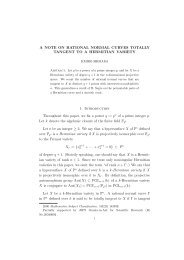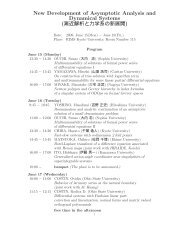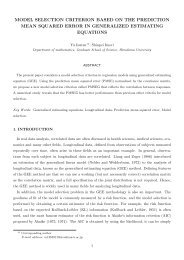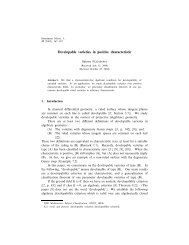LECTURES ON ZARISKI VAN-KAMPEN THEOREM 1. Introduction ...
LECTURES ON ZARISKI VAN-KAMPEN THEOREM 1. Introduction ...
LECTURES ON ZARISKI VAN-KAMPEN THEOREM 1. Introduction ...
Create successful ePaper yourself
Turn your PDF publications into a flip-book with our unique Google optimized e-Paper software.
<strong>LECTURES</strong> <strong>ON</strong> <strong>ZARISKI</strong> <strong>VAN</strong>-<strong>KAMPEN</strong> <strong>THEOREM</strong> 17<br />
map (n, h) ↦→ h defines a surjective homomorphism ρ : N ⋊ H → H whose kernel<br />
is N. Hence H can be identified with (N ⋊ H)/N . The map h ↦→ (e N ,h) defines<br />
an injective homomorphism σ : H → N ⋊ H such that ρ ◦ σ =id H .Byσ, we can<br />
regard H as a subgroup (not normal in general) of N ⋊ H. We have thus obtain a<br />
splitting short exact sequence<br />
σ<br />
←−<br />
1 −→ N −→ N ⋊ H −→ H −→ <strong>1.</strong><br />
ι ρ<br />
Example 5.4.<strong>1.</strong> Suppose that H acts on N trivially. Then N ⋊ H is the direct<br />
product N × H.<br />
Example 5.4.2. Suppose that Z/(2) acts on Z/(n) byx ↦→ −x. Then N ⋊ H is<br />
the dihedral group of order 2n.<br />
Let G be a group, N a normal subgroup of G, and ι : N↩→ G the inclusion map.<br />
We denote G/N by H, and let ρ : G → H be the natural surjective homomorphism.<br />
An injective homomorphism σ : H → G such that ρ ◦ σ =id H is called a section of<br />
ρ. Suppose that a section σ : H → G of ρ exists.<br />
σ<br />
←−<br />
1 −→ N −→ G −→ H −→ <strong>1.</strong><br />
ι ρ<br />
We can define an action of H from right by<br />
n ↦→ σ(h) −1 nσ(h)<br />
(n ∈ N,h ∈ H).<br />
Then the semi-direct product N ⋊ H constructed from this action is isomorphic to<br />
G. The isomorphism from G to N ⋊ H is given by<br />
and its inverse is given by<br />
g ↦→ (g · σ(ρ(g)) −1 ,ρ(g))<br />
(n, h) ↦→ ι(n)σ(h)<br />
5.5. The fundamental group of the total space.<br />
Proposition 5.5.<strong>1.</strong> Let p : E → B be a locally trivial fiber space with a section<br />
s : B → E. Suppose that E is path-connected. Let b be a base point of B, and<br />
put ˜b := s(b), F b := p −1 (b). Then π 1 (E,˜b) is isomorphic to the semi-direct product<br />
π 1 (F b , ˜b)⋊π 1 (B,b) constructed from the monodromy action of π 1 (B,b) on π 1 (F b , ˜b).<br />
Proof. First note that F b and B are path-connected, because E is path-connected<br />
and there is a section s. (The union of the path-connected components of fibers<br />
that contain the point of the image of s form a path-connected component of E,<br />
and hence it coincides with E.) Let i : F b ↩→ E be the inclusion. We have the<br />
homotopy exact sequence<br />
i<br />
−→<br />
∗<br />
π2 (E,˜b) −→ p∗<br />
i∗<br />
π 2 (B,b) −→ π 1 (F b , ˜b) −→ π 1 (E,˜b) −→ p∗<br />
π 1 (B,b) −→ <strong>1.</strong><br />
Note that π 0 (F b , ˜b) = <strong>1.</strong> There is a homomorphism s ∗ : π 2 (B,b) → π 2 (E,˜b) such<br />
that<br />
π 2 (B,b) −→ s∗<br />
π 2 (E,˜b) −→ p∗<br />
π 2 (B,b)<br />
is the identity. Therefore p ∗ : π 2 (E,˜b) → π 2 (B,b) is surjective, and hence we obtain<br />
a short exact sequence<br />
i∗<br />
1 −→ π 1 (F b , ˜b) −→ π 1 (E,˜b) −→ p∗<br />
π 1 (B,b) −→ <strong>1.</strong>






